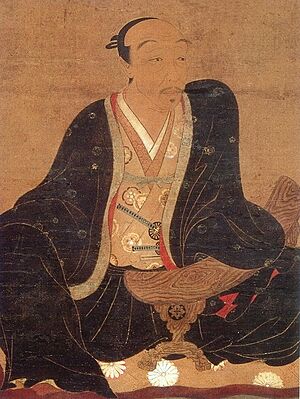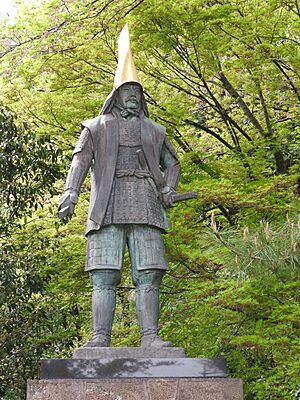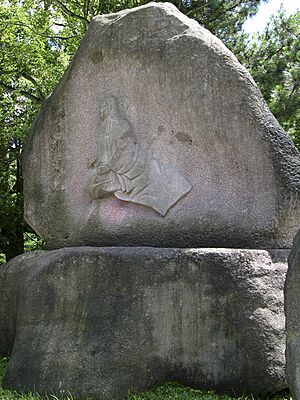Maeda Toshiie facts for kids
Quick facts for kids
Maeda Toshiie
前田 利家 |
|
|---|---|

Maeda Toshiie
|
|
| Head of Maeda clan | |
| In office 1560–1599 |
|
| Preceded by | Maeda Toshimasa |
| Succeeded by | Maeda Toshinaga |
| Lord of Kanazawa | |
| In office 1583–1599 |
|
| Succeeded by | Maeda Toshinaga |
| Personal details | |
| Born |
Inuchiyo (犬千代)
January 15, 1538 Arako, Owari Province |
| Died | April 27, 1599 (aged 61) Kanazawa, Kaga Province |
| Nationality | Japanese |
| Spouse | Maeda Matsu |
| Parents |
|
| Nicknames | "Inu" (dog) "Yari-no-Mataza" "Matazaemon" |
| Military service | |
| Allegiance | |
| Rank | Daimyo, Dainagon |
| Unit | |
| Commands | Kanazawa Castle |
| Battles/wars | Battle of Kiyosu Battle of Ino Battle of Ukino Battle of Okehazama Battle of Moribe Siege of Inabayama Siege of Kanegasaki Battle of Anegawa Echizen Campaign Battle of Nagashino Kaga Campaign Battle of Tedorigawa Battle of Shizugatake Siege of Suemori Siege of Hachigata Siege of Hachiōji Siege of Odawara Kunohe rebellion |
Maeda Toshiie (前田 利家, January 15, 1538 – April 27, 1599) was a powerful Japanese general. He lived during the Sengoku period (a time of civil war) and the Azuchi–Momoyama period. Toshiie was one of the most trusted leaders under Oda Nobunaga, a famous warlord.
He was known for his skill with a yari (a Japanese spear). People called him "Yari no Mataza" or "Matazaemon" because of this. He was also part of a special group of three generals known as the Echizen Triumvirs. Later in his life, he reached a very high court rank called Dainagon.
Contents
Maeda Toshiie: A Brave Samurai Leader
Early Life and Nicknames
Maeda Toshiie was born in 1538 in a village called Arako. His father was Maeda Toshimasa, and his wife was Maeda Matsu. As a child, his name was "Inuchiyo." He was the fourth of seven brothers.
From a young age, Toshiie served Oda Nobunaga. He started as a page, which was like an assistant. Nobunaga trusted him a lot. It was unusual for a fourth son to become the head of his family, but Toshiie's loyalty was rewarded.
Like Nobunaga, Toshiie was a bit of a rebel in his youth. He often dressed in a flashy, unusual style called kabukimono. He was also friends with Kinoshita Tokichiro, who later became Toyotomi Hideyoshi. Nobunaga nicknamed Hideyoshi "Monkey" (Saru). It's believed he called Toshiie "Dog" (Inu). People often thought of Toshiie as serious, unlike the more outgoing Hideyoshi.
A Life in Battles
Toshiie started his military career in a special unit. This group was called the akahoro-shū, or "Red Mantle group." They wore red cloaks on their backs. Later, he became an infantry captain, leading foot soldiers in Nobunaga's army. Eventually, he became the main leader of the Akahoro-shū.
During his time as a soldier, Toshiie met many important people. These included Toyotomi Hideyoshi, Sassa Narimasa, and Niwa Nagahide. He also had a long-standing rivalry with Tokugawa Ieyasu. After a victory against the Asakura clan, Toshiie fought under Shibata Katsuie in the Hokuriku area of Japan.
Toshiie fought in many important battles:
- In 1554, he joined his first war, the Battle of Kiyosu Castle.
- In 1556, he fought against Nobunaga's younger brother in the Battle of Ino.
- Around 1558, he earned his nickname "Yari no Matazaemon" for his spear skills. This was during the Battle of Ukino.
- He also fought in the famous Battle of Okehazama in 1560.
- Other battles included the Siege of Inabayama (1567), Siege of Kanegasaki (1570), Battle of Anegawa (1570), Battle of Nagashino (1575), and Battle of Tedorigawa (1577).
In 1580, Toshiie was given control of a large area of land. This included the Noto and Kaga provinces. Kaga became very rich, known as Kaga Hyaku-man-goku (meaning "Kaga of one million koku"). A koku was a measure of rice, showing how wealthy a region was. Toshiie had many skilled helpers who managed his lands well.
Changing Alliances and Victories
In 1582, Oda Nobunaga was killed. After this, there was a meeting to decide the future of Nobunaga's clan. Toshiie first supported Shibata Katsuie. However, in 1583, during the Battle of Shizugatake, Toshiie switched sides to support Toyotomi Hideyoshi.
After Shibata Katsuie was defeated, Toshiie became a leading general for Hideyoshi. In 1584, he fought against his friend Sassa Narimasa in the Battle of Suemori Castle. Toshiie's forces were much larger, and he defeated Narimasa.
In 1587, Toshiie helped a Christian lord named Dom Justo Takayama. This lord had been forced out of his position by the shogun's order against Christians.
Later, in 1590, Toshiie played a big part in the Odawara Campaign. He and Uesugi Kagekatsu led a large army. They captured many castles before finally taking Hachioji Castle. In 1591, he also helped put down the Kunohe rebellion with Tokugawa Ieyasu.
Later Years and Legacy
In 1598, Toyotomi Hideyoshi died. Before his death, Hideyoshi chose Toshiie to be one of the "Council of Five Elders." This council was meant to help Hideyoshi's young son, Toyotomi Hideyori, rule Japan until he was old enough.
However, Toshiie was also very sick. He could only support Hideyori for about a year before he died in 1599. After Toshiie's death, his son, Maeda Toshinaga, took over. Tokugawa Ieyasu saw this as a chance to gain more power. He accused Toshinaga of plotting against him.
Toshinaga denied the accusations. But Ieyasu demanded that Toshinaga's mother, Maeda Matsu, be sent as a hostage. There was a big debate in the Maeda clan. Some wanted to fight Ieyasu. Others wanted to surrender. Finally, Matsu herself convinced them. She said, "For a samurai family, keeping the family safe is most important. Don't destroy the family just for me."
So, Matsu went to Ieyasu as a hostage. This meant the Maeda clan became allies with the Tokugawa clan. They fought on Ieyasu's side in the important Battle of Sekigahara in 1600.
Maeda Toshiie's Family
Toshiie's wife, Maeda Matsu, was famous in her own right. She was strong and skilled in martial arts. She helped Toshiie become successful. After her husband died, Matsu, known as Hoshun-in, made sure the Maeda clan stayed safe. She did this by willingly going as a hostage to Edo, the capital of the new shogun, Tokugawa Ieyasu. She had disliked Ieyasu for a long time, watching him, her husband, and Hideyoshi compete for power.
Toshiie and Matsu had many children. Their sons became important lords, and their daughters married into powerful families. This helped the Maeda clan stay strong and influential for many years.
The Ōdenta Sword
One famous item connected to Maeda Toshiie is the "Ōdenta" sword. It means "Great Denta" and was considered one of the best swords made by a swordsmith named Denta. This sword was once owned by the Ashikaga shoguns. Later, it was passed down to Maeda Toshiie.
There are legends about the Ōdenta sword. One story says it healed Toshiie's daughter. Another legend claims that birds would never fly near a building where this sword was kept.
See also
 In Spanish: Maeda Toshiie para niños
In Spanish: Maeda Toshiie para niños
- Battle of Nagashino
- Maeda Toshiie in popular culture




